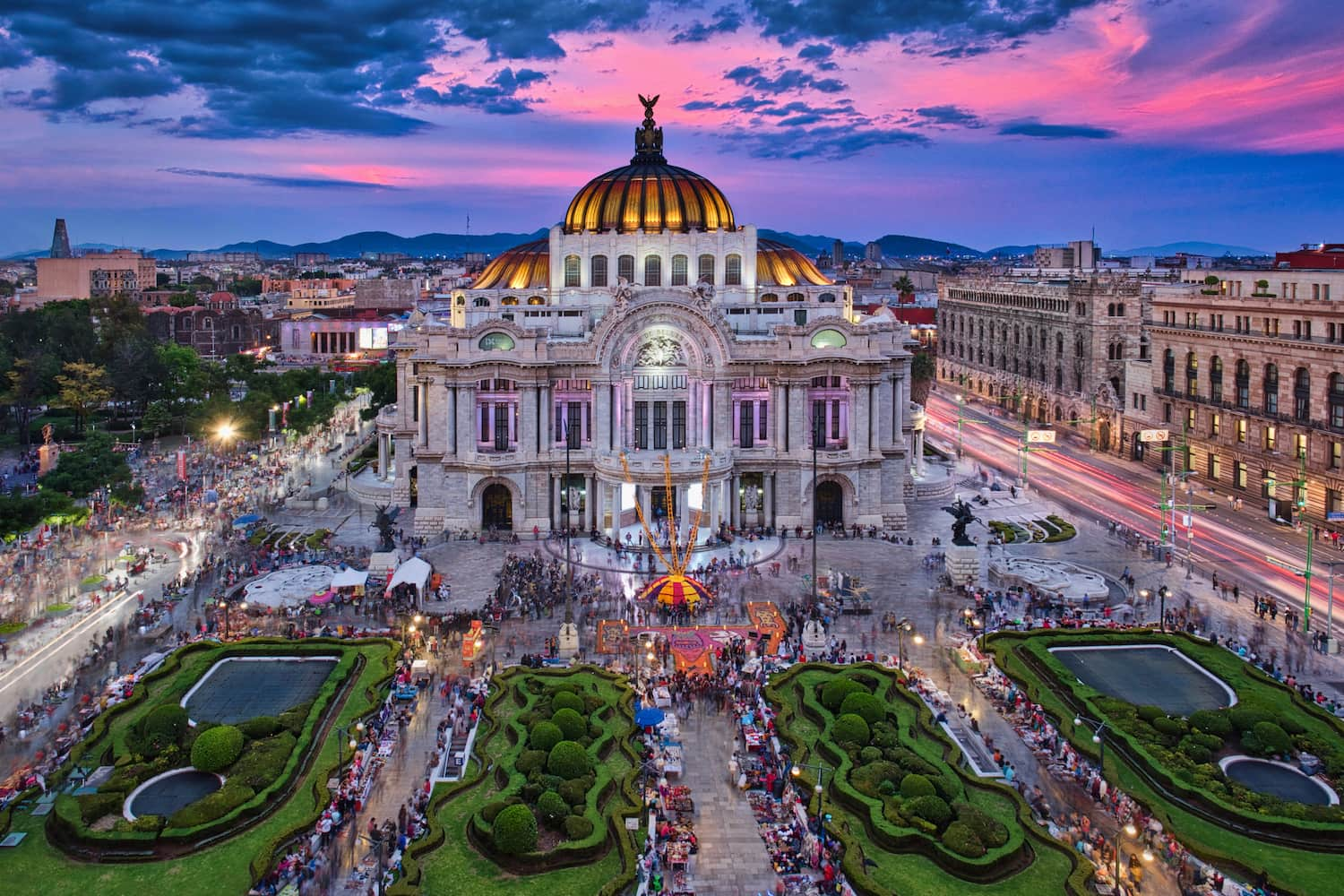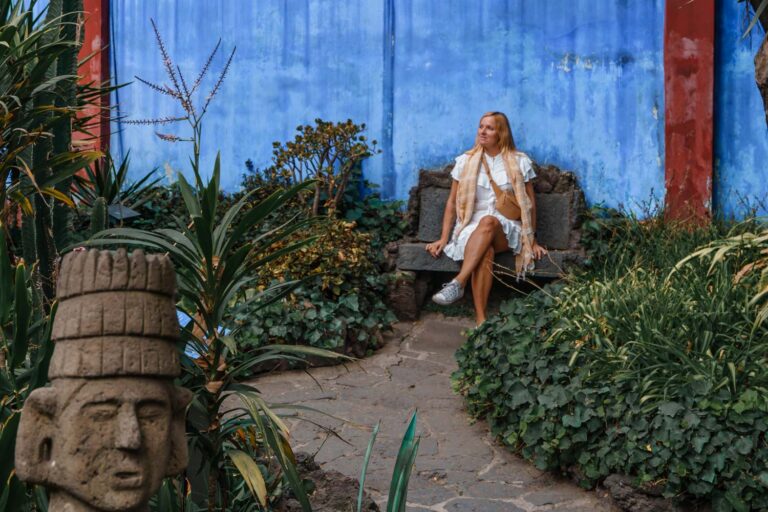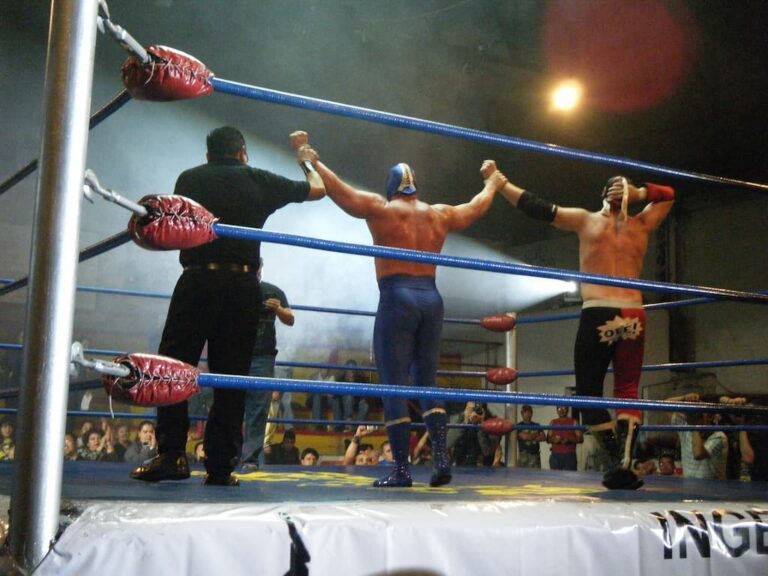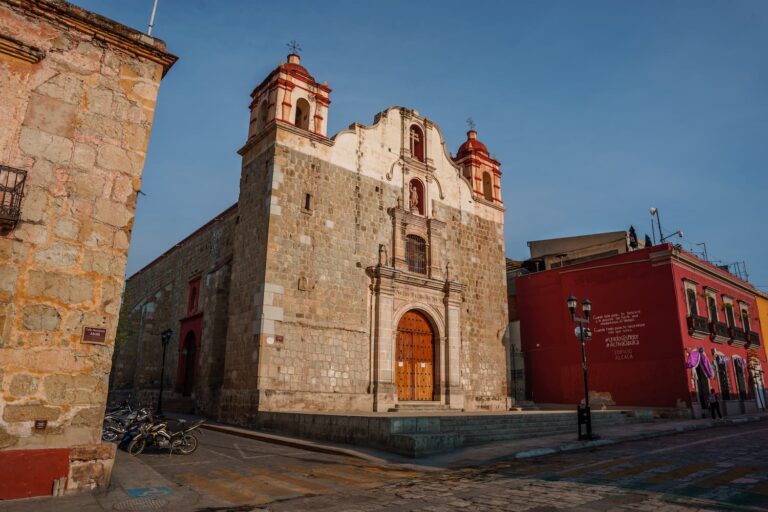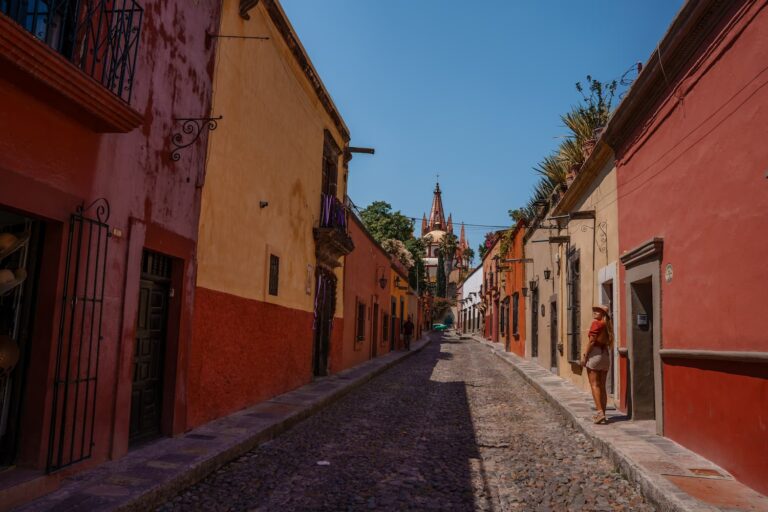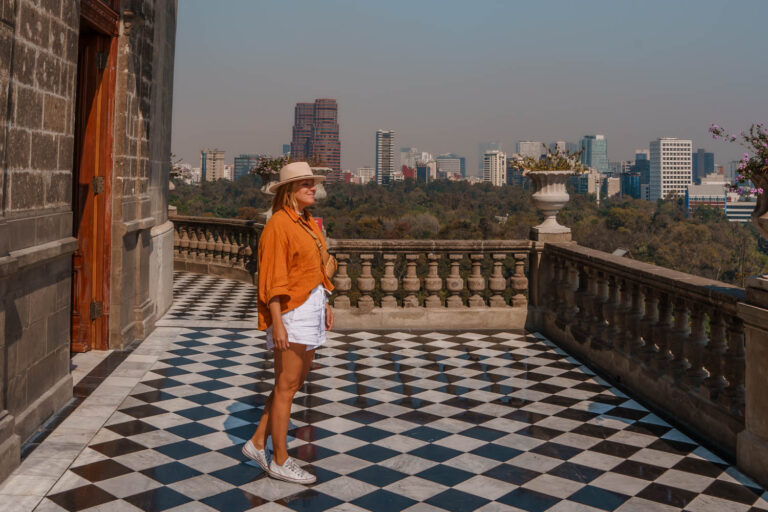29 Most Famous Landmarks In Mexico City

Whether your holiday is scheduled to last three days or a whole week, there are enough iconic landmarks in Mexico City to keep you fully occupied. The sprawling metropolis has man-made marvels spread throughout its boroughs, as well as numerous natural wonders that make for fantastic day trips.
Since we started living part-time in the capital, we’ve visited all the famous landmarks Mexico City has to offer. While our favourite activity (so far) has been riding a hot air balloon above Teotihuacan, we’ve also enjoyed more random excursions, like the one we made to the Biblioteca Vasconcelos, a bizarre building described by some as a futuristic prison.
Here, we’ve distilled some of our experiences into a handy list that you can use to plan your own custom itinerary. Aside from the must-see famous sites in Mexico City, this post contains historical curiosities, scenic hikes, and avant-garde architecture so that you can alternate your trip between scaling volcanoes and exploring the surprisingly lavish post office HQ.
Most Famous Landmarks In Mexico City
Let’s start with Mexico City famous landmarks that you absolutely cannot miss. If you’re short on time and don’t have enough days to plan a more expansive trip, these 11 famous places in Mexico City to visit should be at the top of your hit list, from Aztec ruins to masterpieces of art nouveau architecture.
#1 Zócalo (Main Square)
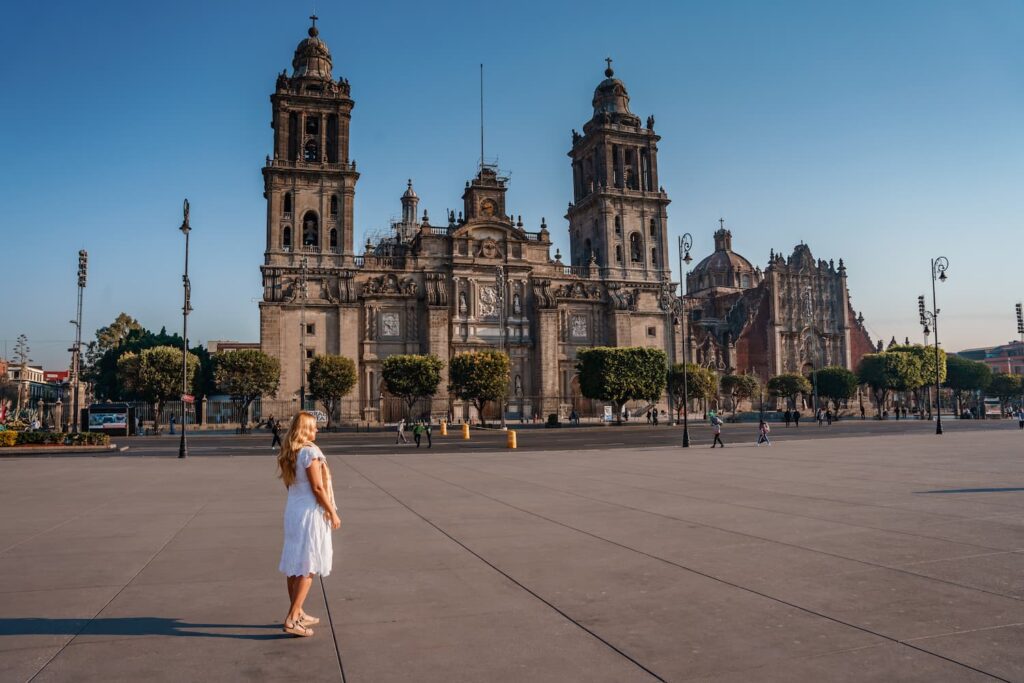
Several historical landmarks in Mexico City are located on the Zocalo, which first held public gatherings all the way back when CDMX was still Tenochtitlan.
On its eastern side is the Palacio National (National Palace), a grand building that acts as the seat of the Mexican government and is home to the famous mural painted by Diego Riviera. We highly recommend visiting since admission is free! Just bring your passport to gain entrance.
To the northern side is Latin America’s oldest and largest cathedral, the Catedral Metropolitana (Metropolitan Cathedral), which is a glorious hodgepodge of architectural styles that took almost 250 years to complete.
Just off the Zocalo, you’ll also discover the ruins of Templo Mayor (Main Temple). There’s not much to see today thanks to the pillaging of the Spanish colonisers, though we recommend the museum for a collection of pre-Columbian artefacts.
#2 Chapultepec Castle
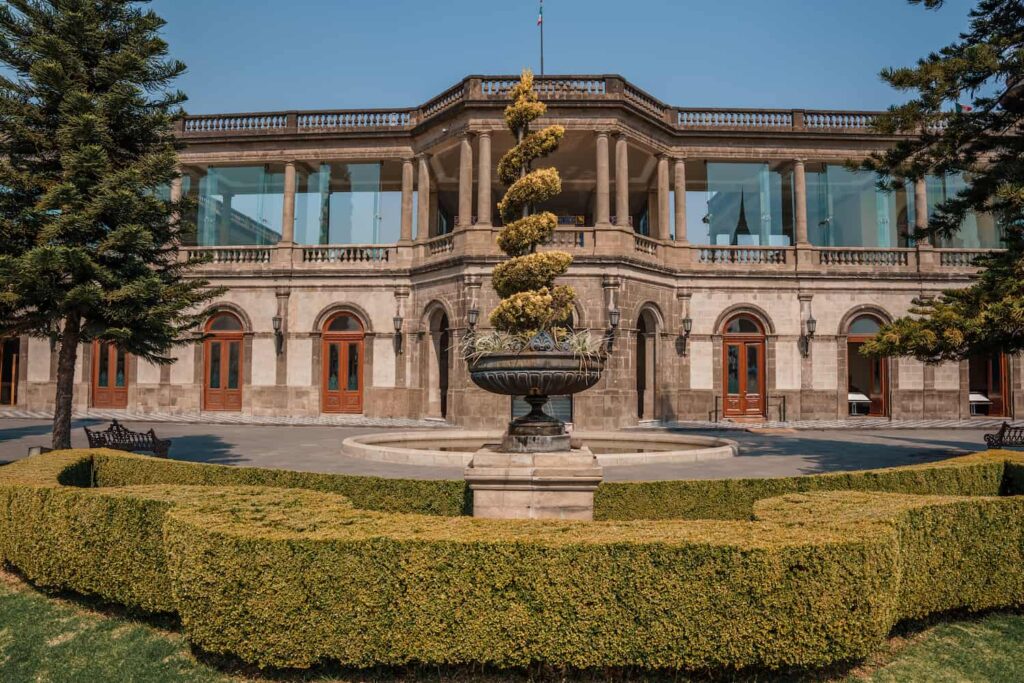
The Bosque de Chapultepec (Chapultepec Forest) is a sprawling area that covers 1,700 acres – about twice as big as New York’s Central Park.
Inside are winding pathways, blooming gardens, and several important museums, including the Museo Nacional de Antropologia (National Museum of Anthropology), which is dedicated to pre-Hispanic culture, and the Museo de Arte Moderno (Museum of Modern Art), which contains pieces by Frida Kahlo, Diego Rivera, and Leonora Carrington.
When the weather is fine, we particularly recommend renting a boat and rowing out onto the lake, though, in all seasons, the parkland is a lovely place to while away an hour or two.
Overlooking it all is Chapultepec Castle, which sits atop the highest point of the park and has excellent views of the surrounding nature as well as the city skyline. Built in the late 1700s, today it houses the Museo Nacional de Historia (National Museum of History).
#3 Teotihuacan
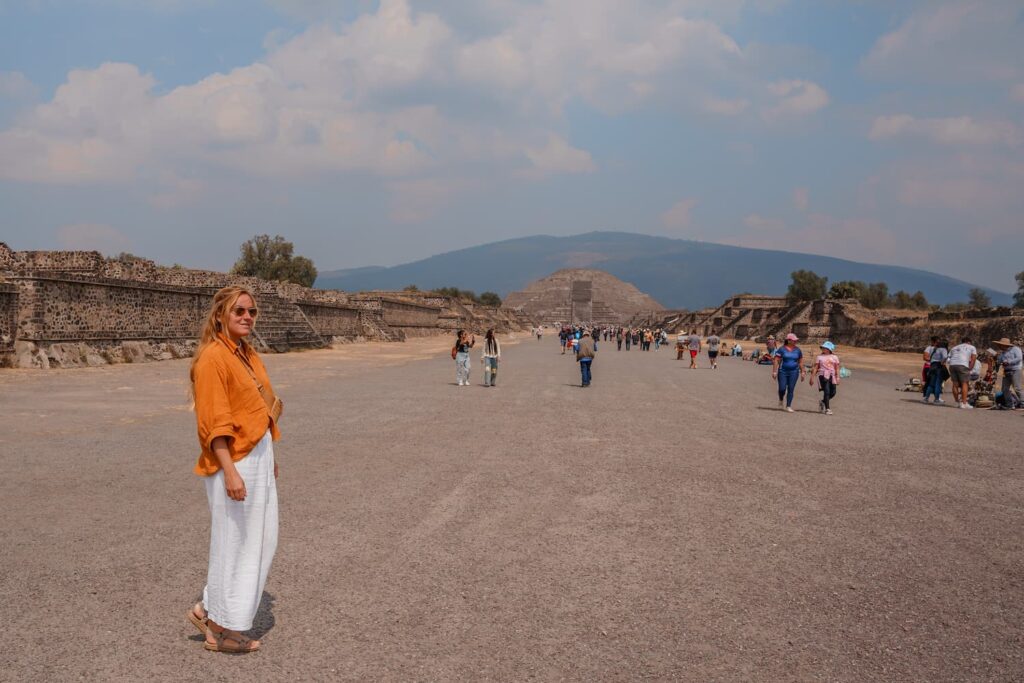
Just on the outskirts of CDMX is one of the best-preserved examples of Mesoamerican architecture, Teotihuacan. This city was built more than a thousand years before the advent of the Aztecs and contains one of the largest ancient pyramids in the world, the Temple of the Sun.
We actually took a hot air balloon ride over the site, and it was one of the highlights of our trip, allowing us to take in the ruins from a whole new perspective. There are quite a few different operators offering experience, but here’s the one we tried.
#4 Frida Kahlo Museum
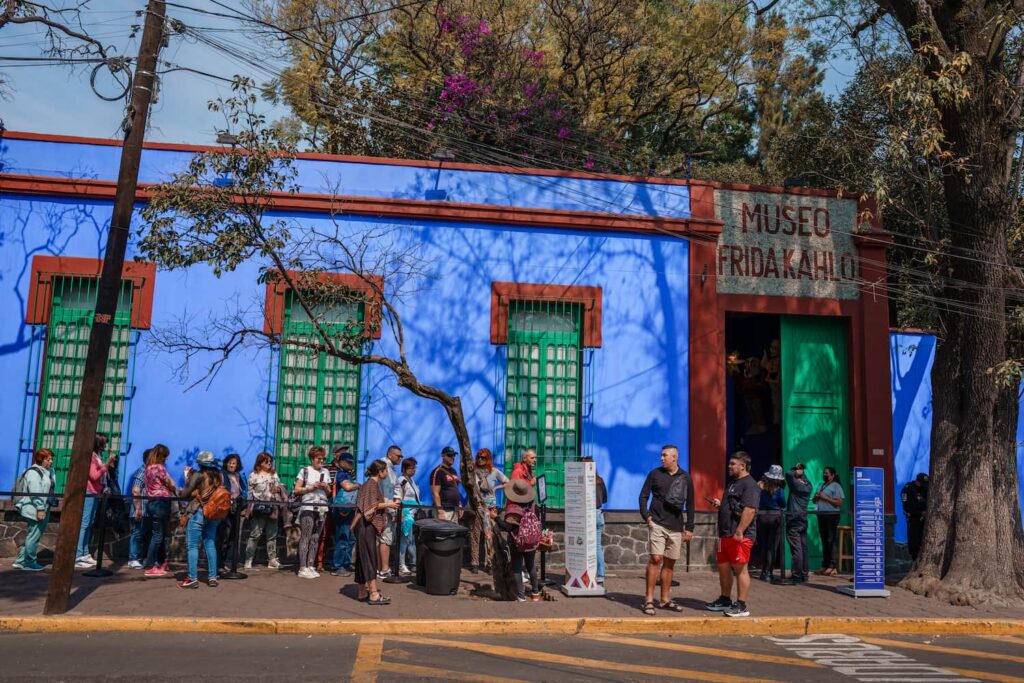
Nested in the leafy southern borough of Coyoacan, the Frida Kahlo Museum is fittingly situated inside the Mexican artist’s former home. You won’t need to ask for directions, as the bright blue building, informally known as the Casa Azul, sticks out like a sore (Smurf) thumb.
The interiors have been preserved to reflect the way they would have looked when Kahlo still inhabited the house with her husband and fellow artist Diego Rivera, with easels in the studio and fabrics with indigenous designs on the coverlets.
Entry is 250 pesos (approximately $14.50), and the museum is open every day except Monday.
#5 Palacio de Bellas Artes
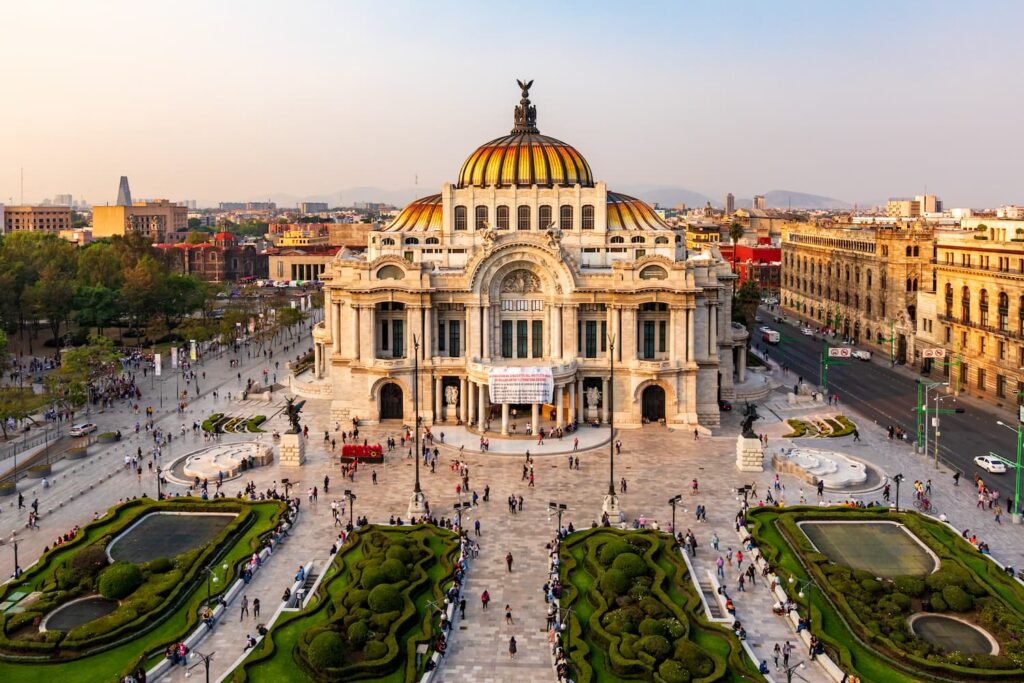
One of the most recognisable landmarks in Mexico City, the Palacio de Bellas Artes (Palace of Fine Arts) is an elaborately conceived construction that has an art nouveau façade with distinctive orange roofing. We suggest heading to the 8th floor of the Sears building opposite, where there’s a café from which you can take in the full effect (like on the picture above).
In contrast to the art nouveau outside, the inside is quintessential art deco. That’s not by original design, but because by the time people got around to the interior, the fashions had moved on! Take your time examining the intricate murals, including the Diego Rivera masterpiece El Hombre en el Cruce de Caminos (Man at the Crossroads).
#6 Xochimilco
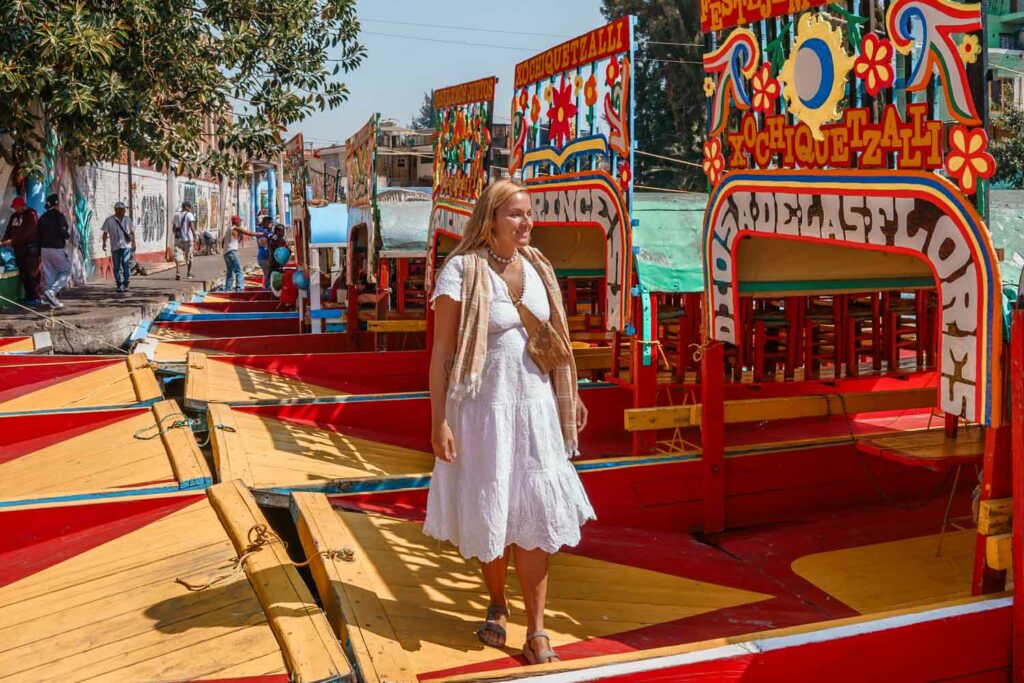
For a different look at Mexican culture, head to the Xochimilco water gardens and hop on a flat-bottomed trajinera boat. This UNESCO World Heritage Site began as a canal system back in pre-Hispanic times, but today, it’s a kind of floating party place where people come to celebrate with margaritas, tacos al pastor, and live music.
It can be a bit of a pain negotiating your own berth on a trajinera (trust us, as we did it), and it’s also not as fun to just be on your own on a boat. Instead, we recommend heading there on a tour if you’re not confident in your Spanish.
#7 Coyoacán
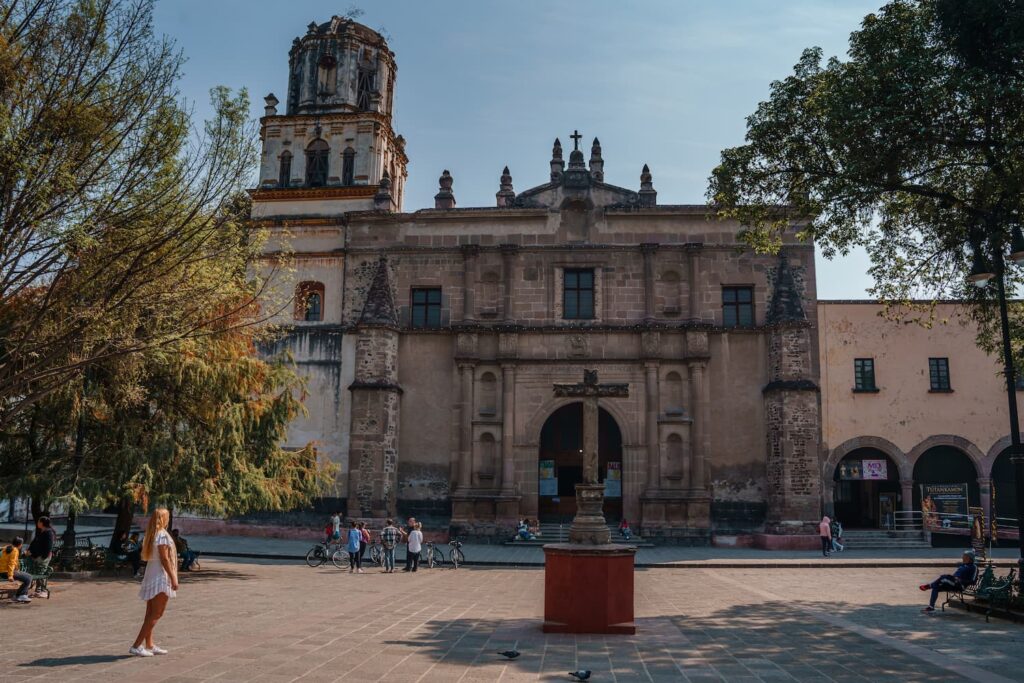
There’s a lot more to Coyoacan than just the Frida Kahlo Museum. While you’re in the area, make sure to pay a visit to the Mercado de Coyoacan, where you can munch on street food like octopus-topped tostadas and quesadillas while picking up a souvenir or two.
Pretty cobblestone streets lined with trees emanate outwards from the Fuente de Los Coyotes (Fountain of the Coyotes), which pays tribute to Coyoacan’s name (‘place of coyotes’ in Nahuatl).
If you have a bit of spare time, head deeper into Coyoacan to the Museo Diego Rivera Anahuacalli, which is worth visiting just for the incredible building made from black volcanic stone.
#8 Torre Latinoamericana
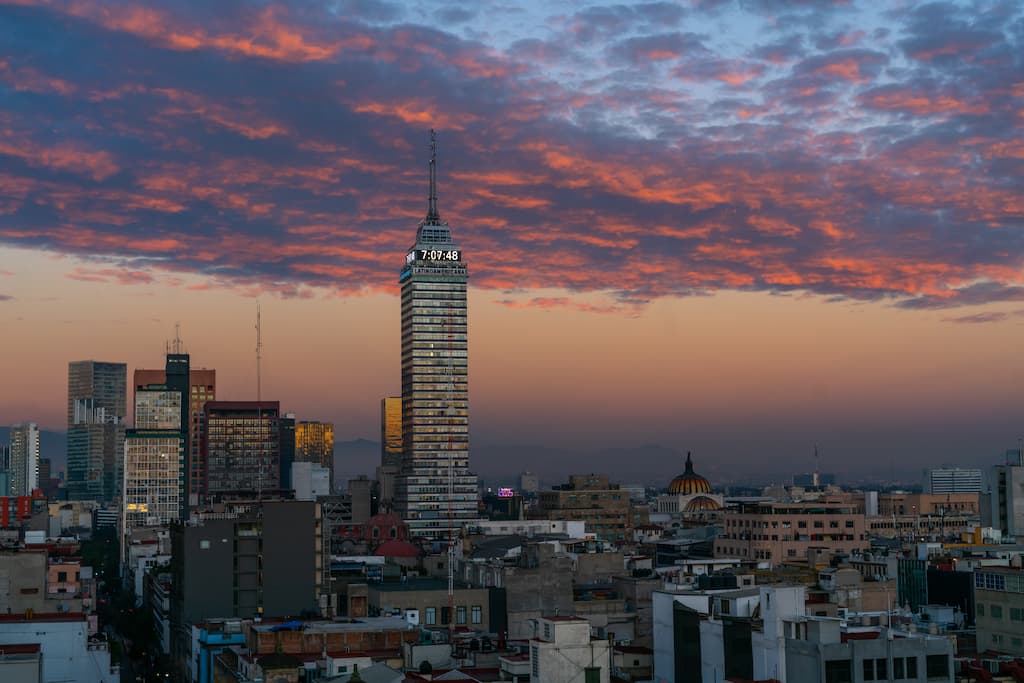
It’s hard to miss the Torre Latinoamericana (Latin American Tower), which is the tallest building in Mexico City’s historic centre (Centro Historico). Built to withstand seismic activity caused by earthquakes, it has some of the best panoramic views of the city thanks to its excellent location in the middle of the metropolis.
The very top of the building has an observation deck that costs 180 pesos to enter, but we suggest going to the bar a couple of floors down, where you can enjoy the views and a drink for roughly the same cost.
#9 La Ciudadela
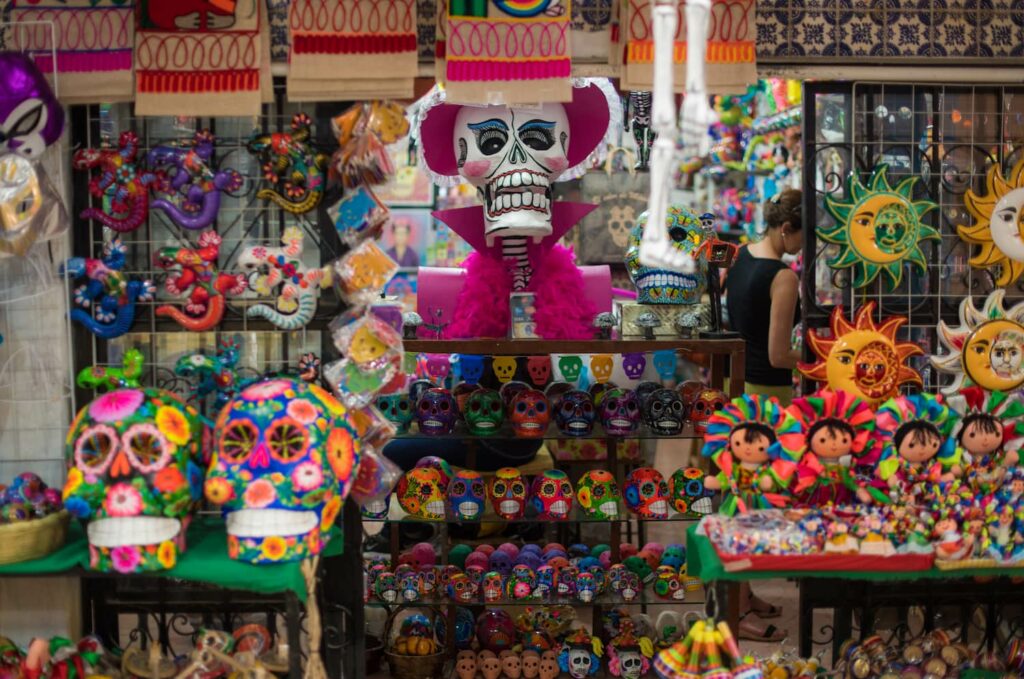
The Mercado de Artesanías La Ciudadela, known more informally as just La Ciudadela, is the place to go for Mexican arts and crafts, from traditional clothing like sarapes (blankets), rebozos (shawls) and huaraches (sandals), to the colourful alebrijes papier-mâché sculptures that are a CDMX speciality.
Many of the stalls are operated by independent sellers, who hail from all over Mexico’s 32 states. Even if you don’t end up buying any of the items on display, it’s an interesting place to visit for a look at the different facets of the country’s culture.
#10 National Palace (Palacio Nacional)
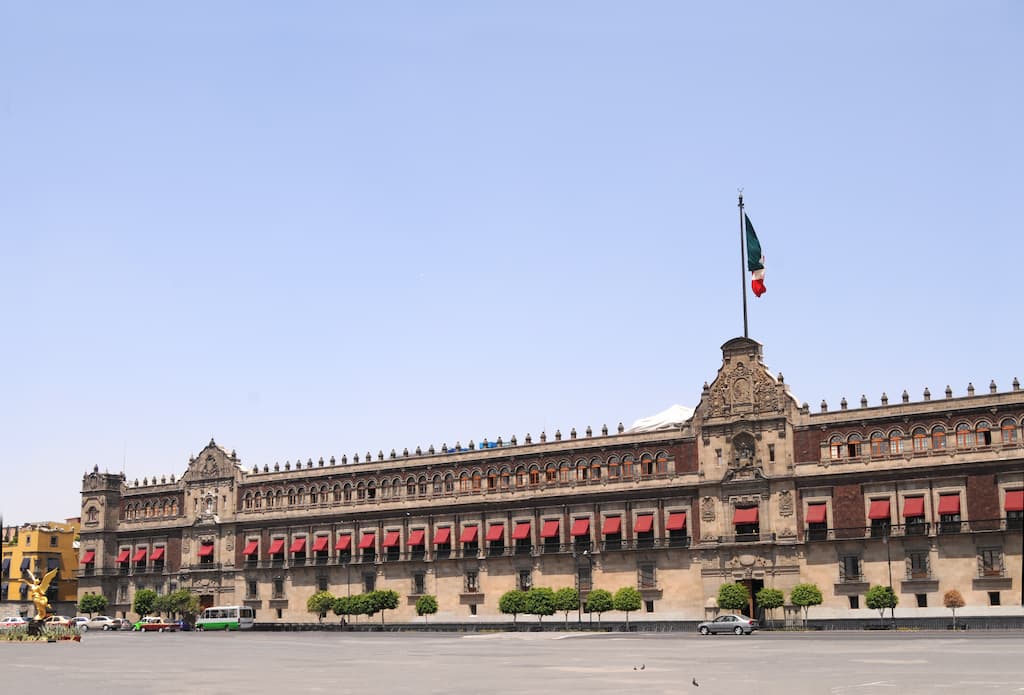
The Palacio Nacional has reopened post-COVID, but you’ll need to book a guided tour to get inside. This is free to do but not particularly intuitive to organise since you’ll have to turn up on the day and take your chances as to whether there’s a tour available at a time that suits your schedule (no tours on Mondays).
If you do manage to get inside, you’ll be treated to grandiloquent interiors and another of Diego Rivera’s most famous murals, the History of Mexico.
#11 Arena Mexico
The Arena Mexico is one of the most famous landmarks in Mexico City not because of the building itself, which isn’t particularly impressive, but for what’s contained inside. This is the home of lucha libre, the colourful, performative wrestling style that is a national pastime in Mexico.
While the experience itself is unmissable, we found the area around the Arena pretty unsavoury, so you might want to hop on a tour that will arrange not just tickets for you but also take you to a local taqueria and cantina for some tacos and mezcal beforehand.
Natural Landmarks In Mexico City
The outskirts of the capital are filled with stunning natural areas where you can escape the crowds and commune with the wild. Many of these places aren’t easy to reach by public transport, so you’ll have to rely on Uber, car hire, or tours to get to these tranquil spots.
#12 Desierto de los Leones National Park

The ‘Desert of the Lions’ National Park is to the southwest of CDMX, about 30 to 45 minutes’ drive from downtown. Rather than a desert, as the name suggests, the park is mostly forest, veined with hiking trails and bike routes.
One of the highlights here is the old Carmelite convent, which makes for a picturesque ruin amidst the trees. Street food stalls dot the area if you want a snack, though it makes for an excellent picnic location on warm days.
#13 Ajusco
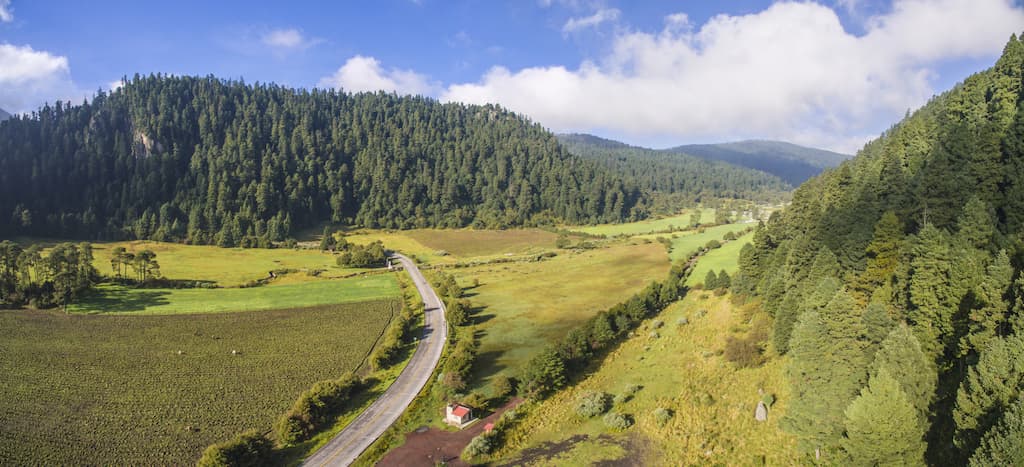
Ajusco is an extinct volcano about one hour to 90 minutes out of town, depending on traffic. On weekends, the road tends to get busy, as the pine-covered mountain is a popular place for Mexico City denizens to get their exercise while breathing crisp, fresh air.
While we hiked the peak in March, we’ve been told it’s possible to make the ascent throughout the year, always provided you’re in decent shape. Allocate about half a day for a round trip.
Bikes and horses can be rented on-site if you fancy an excursion that’s easier on your feet.
#14 Parque Nacional Iztaccíhuatl-Popocatépetl
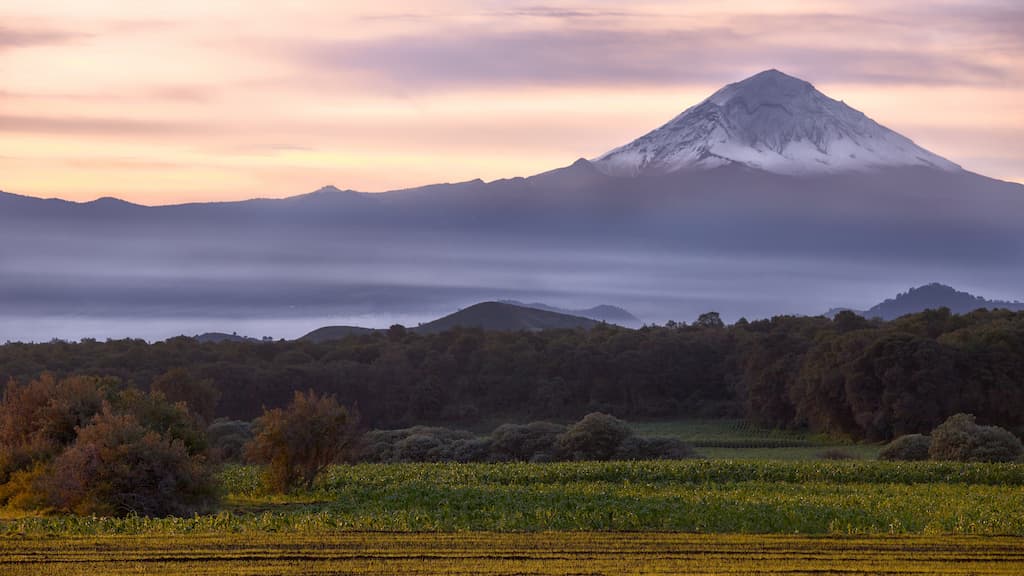
Deeper into the countryside (2.5 hour drive from CDMX), the volcanoes of Iztaccíhuatl and Popocatépetl are two of the biggest mountains in Mexico. Since Popocatépetl is still active (it last erupted in May 2023), Iztaccíhuatl is the one that ambitious hikers make it their mission to ascend, even if it is prone to giving people altitude sickness.
If you don’t fancy taking on 17,160 feet (5,230 metres), it’s possible just to hike part of the way up Iztaccíhuatl, or you can drive up to the Paso de Cortés car park and enjoy a leisurely perambulation on relatively flat ground for views of the peaks – without actually having to climb them!
#15 Nevado de Toluca
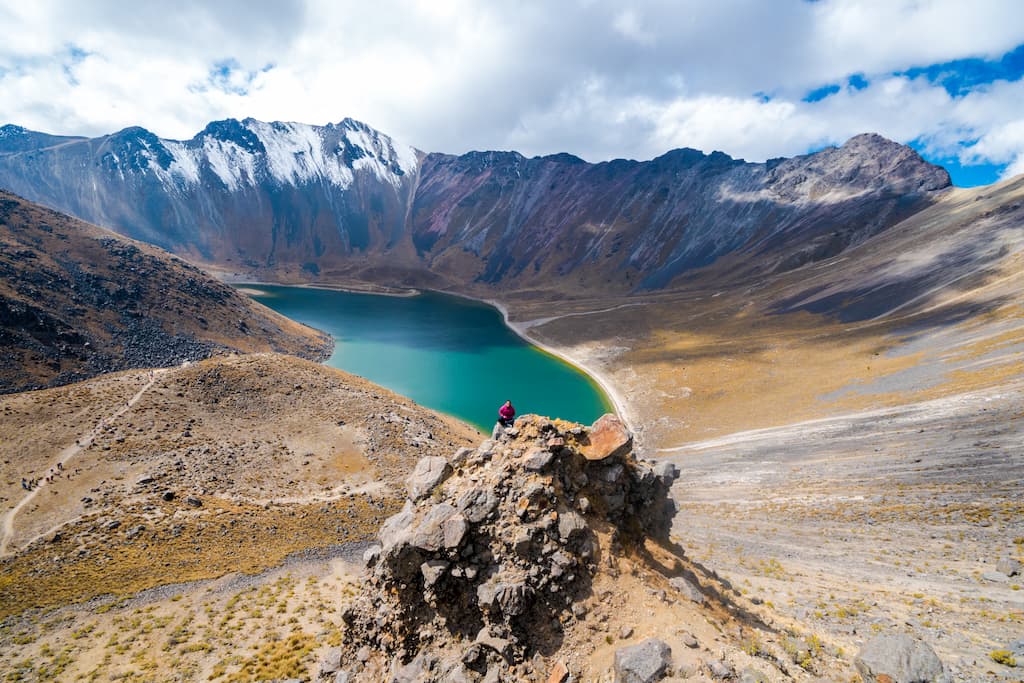
Mexico is full of volcanoes, as you’ve probably realised by this point. Some are active, some are dormant, and some are extinct.
Nevado de Toluca is one of the extinct ones and another excellent place for some hiking. What sets this volcano apart is that the expansive crater now holds a couple of lakes, which provide a magical contrast to the surrounding mountain.
It’s quite a drive out here – we took about 3 hours – so you might want to stay overnight in Toluca to break your journey.
#16 Los Dinamos
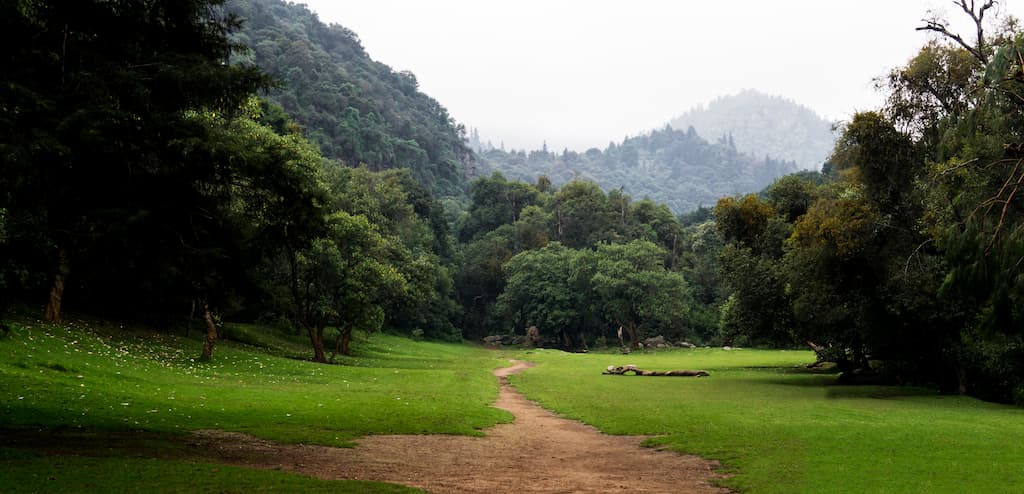
Moving away from volcanoes and vertiginous heights, Los Dinamos is a national park that’s centred on a canyon that has a river running through it. The area is popular for rock climbers and fishers alike, as well as those who chase waterfalls.
A bit closer to the city, Los Dinamos takes about 45 minutes to an hour to reach by car. You can also hop on the metro to Miguel Ángel de Quevedo and then catch a local bus, but this takes about twice as long.
#17 Sierra de Guadalupe
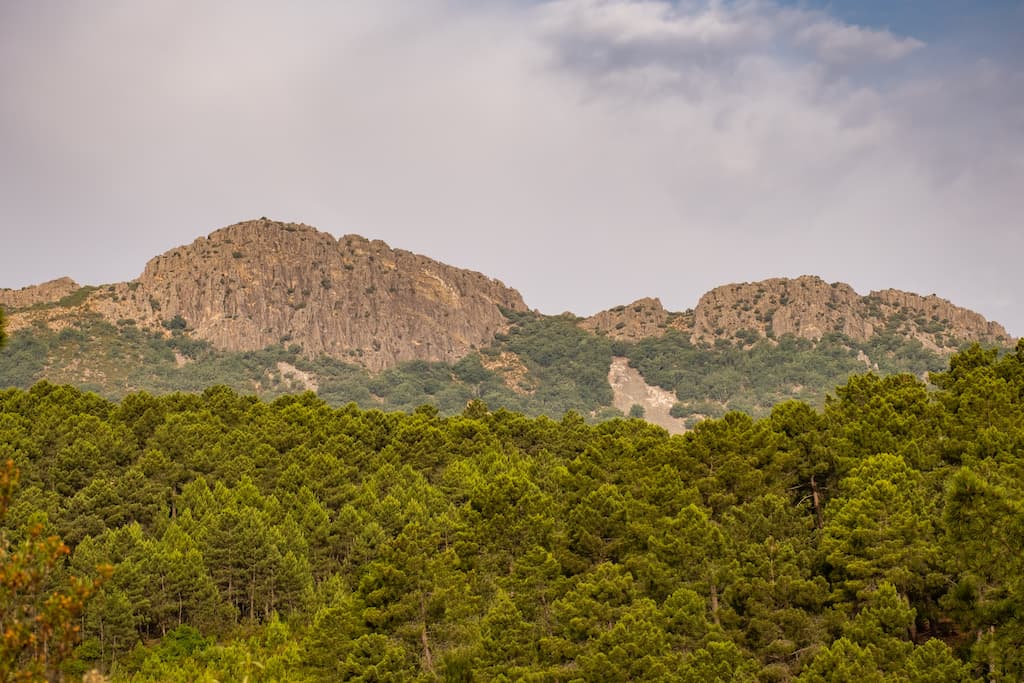
So far, we’ve only focused on the natural areas to the south of CDMX centre, but Sierra de Guadalupe is around an hour north of the city, in a rugged area right on the border of Mexico City and the wider State of Mexico.
While this mountain range doesn’t come up on the typical tourist trail, it’s popular with local families hoping to escape the city for a few hours. The views make for an interesting juxtaposition of the green nature and the densely packed CDMX below.
#18 Parque Nacional Insurgente Miguel Hidalgo y Costilla
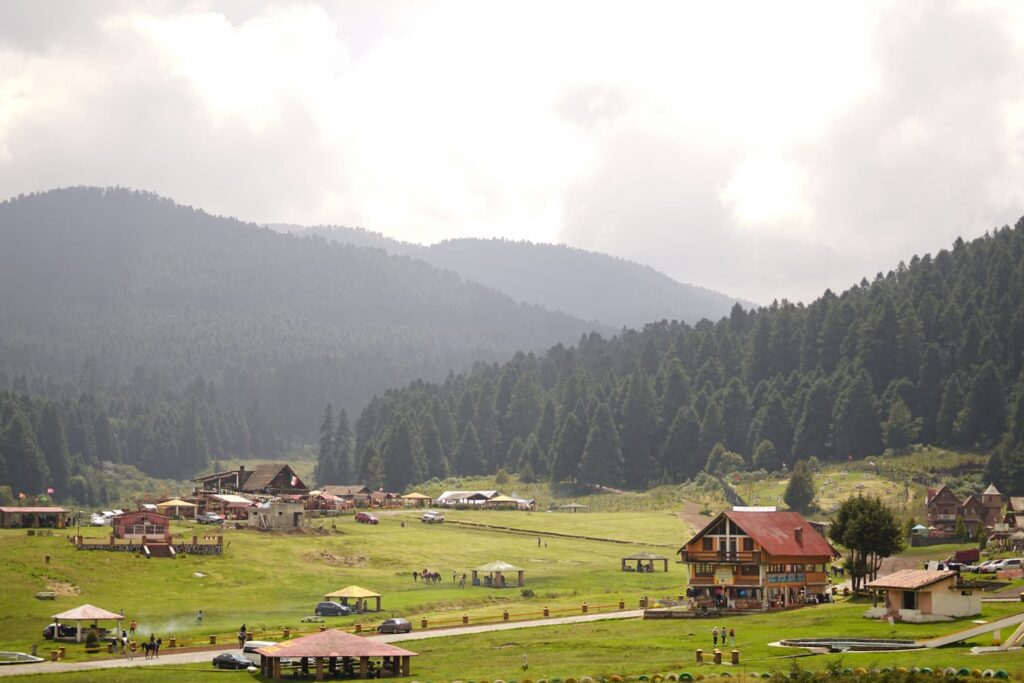
Named for the revolutionary Miguel Hidalgo, most people dispense with this national park’s official title, which is a bit of a mouthful, and just call it La Marquesa. It’s only about 45 minutes to an hour by car from CDMX and has a developed infrastructure. Think of it as one big outdoor recreation centre, complete with canoeing, quad bikes, horse rides, and other activities.
This isn’t the most peaceful place to come for a day out, but it does have lots to do, as well as some delicious food stands – some will cook up the fish you catch in the nearby ponds.
There are also some gentle forest walks that you can take through the surrounding woodland.
Man-Made Landmarks In Mexico City
Beyond the essential list of the capital’s must-see sights, there are several Mexico City historical landmarks that we reckon are worth paying a quick visit if you have a little more time on your hands. These notable constructions are dotted throughout the city, from the Stadio Azteca in the far south to the Basilica de Guadalupe in the north.
#19 Angel of Independence (Ángel de la Independencia)
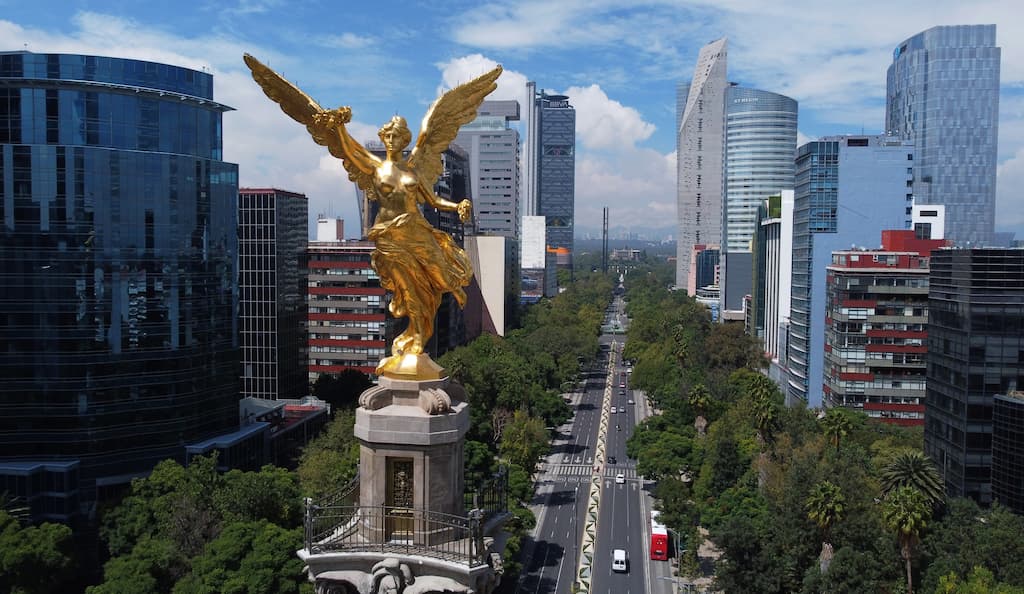
One of the most famous landmarks in Mexico City, the Angel of Independence, is hard to miss. Although it’s called El Angel, the golden statue perched atop the column is actually of Nike, the Greek goddess victory.
Built in 1910, the monument celebrates Mexican independence from the Spanish Empire and was commissioned by former president Porfirio Diaz.
El Angel is right in the heart of modern CDMX, on the main drag of Paseo de la Reforma, surrounded by luxury hotel brands, fancy rooftop bars, and skyscrapers. We imagine the view from the top is pretty spectacular, but you have to get a special permit to go up, so it’s still on our to-do list.
#20 Basilica de Guadalupe
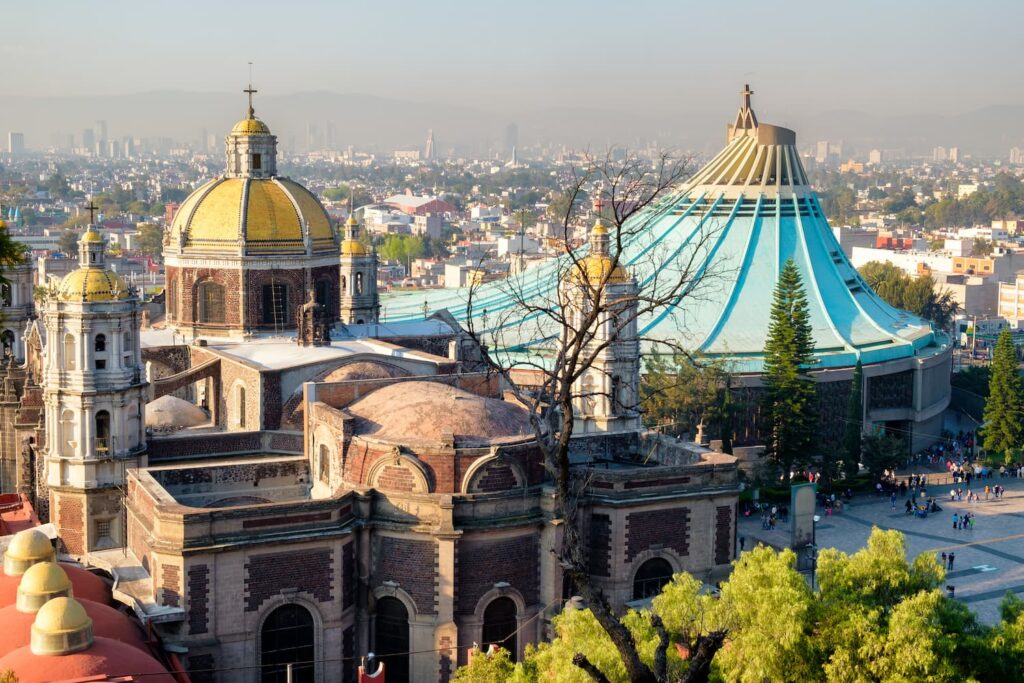
The Basilica of Our Lady of Guadalupe is a marvellously unique building that was erected in the 1970s. Designed by Pedro Ramirez Vasquez, who also masterminded the look of the National Museum of Anthropology, it looks rather like a slightly flattened circus tent and can accommodate around 10,000 people.
This site has been a place of pilgrimage for hundreds of years, and today, there are several interesting religious chapels to visit in the same square, including the Capilla de Indios, the Capilla del Cerrito, and the Capilla del Pocito, as well as the Old Basilica (dating to the 1700s) that used to cater for visitors before it grew too small.
Surprisingly, we found the neighbourhood surrounding the Basilica a bit seedy and not the safest place, so we’d recommend not wandering too far from the tourist flock.
#21 Estadio Azteca
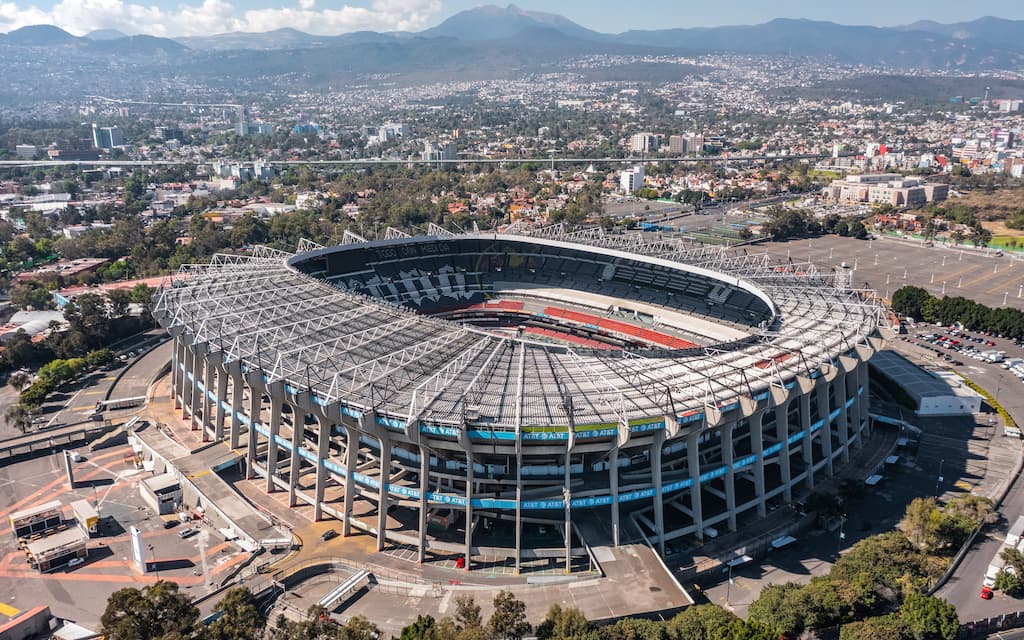
Attracting a different kind of pilgrim, the Estadio Azteca is a must for footie fans. In the past, it’s hosted two FIFA World Cups and an Olympic football tournament, as well as being the home ground for the Mexican national side and two of the country’s big four teams, Club América and Cruz Azul.
You can obviously come here for the full experience on match days (tickets are pretty cheap for basic seats), but for a quieter behind-the-scenes look, there are daily tours around the playing field, the locker rooms, and other backstage areas. Tickets for this are 150 pesos ($8.70) with discounts for children and seniors.
It’s easy to get to the Estadio Azteca either via the bus or using the metro combined with the Xochimilco Light Rail. Alternatively, just Uber it!
#22 Mexico City Metropolitan Cathedral
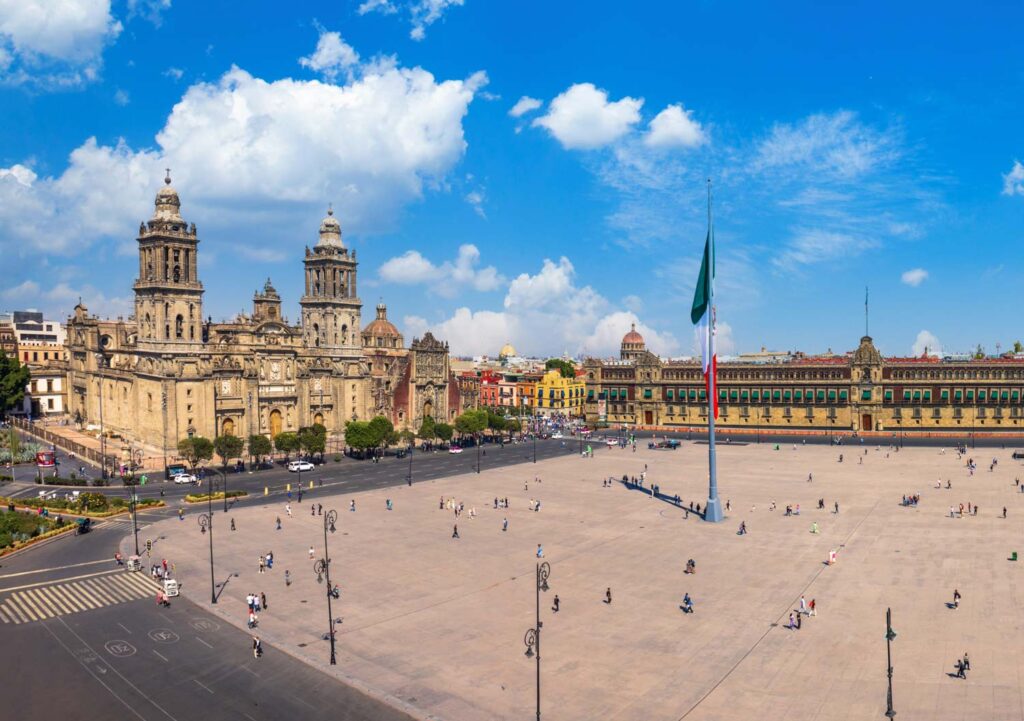
Right off the Zocalo, the Catedral Metropolitana was built over the bones (so to speak) of the old Aztecan temple that once occupied the space. In fact, the colonial administration decided to use stones from the Templo Mayor to construct their hallowed edifice, leaving the pre-Columbian place of worship a ruin.
This took a very long time, and each succeeding generation had a slightly different sense of what was a la mode, which is why you can pick out elements of gothic baroque, churrigueresque, and neoclassical architecture in the cathedral’s design – with the help of a guide, at least!
#23 Soumaya Museum
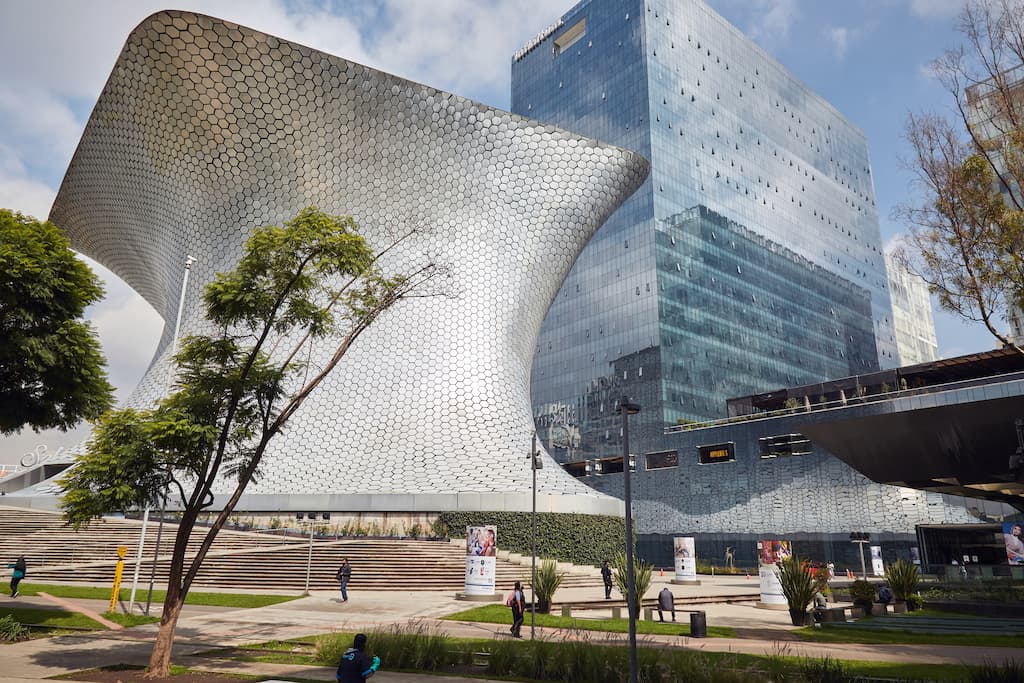
One of our favourite modern landmarks in Mexico City, the Soumaya Museum, is a curvaceous silver beauty that looks like something out of a sci-fi movie. Inside the aluminium-skinned building is an excellent collection of art courtesy of billionaire Carlos Slim, who had it named after his deceased wife.
Entry to the museum is free of charge, making it one of the best places in the world to see art by luminaries such as Da Vinci and Degas, Renoir and Rodin, Botticelli and El Greco without paying a penny. Ironically, the Soumaya is found in the upmarket Polanco neighbourhood, where you can generally expect to spend quite a lot!
#24 Monumento a la Revolución

Appropriately situated in the Plaza de la Republica, the Monumento a la Revolucion (Monument to the Revolution) is one of the tallest memorial arches in the world. The sombre beast of a building rises to 67 metres (220 feet) in height and has a glass elevator at its centre that takes people up to a viewing platform.
We always think of the Monument as a kind of companion piece to El Angel, which is about 25 minutes away along Reforma. Both were started in 1910, but where El Angel was neatly completed within a year, the Monument to the Revolution wasn’t finished until 1938.
That’s largely because Porfirio Diaz originally conceived of it as a palace, whose centrepiece would be a big, impressive cupola. These plans fell apart, and the structure was abandoned until a bright spark came up with the idea of adapting it into an august memorial rather than a surplus palace.
#25 Palacio de Correos
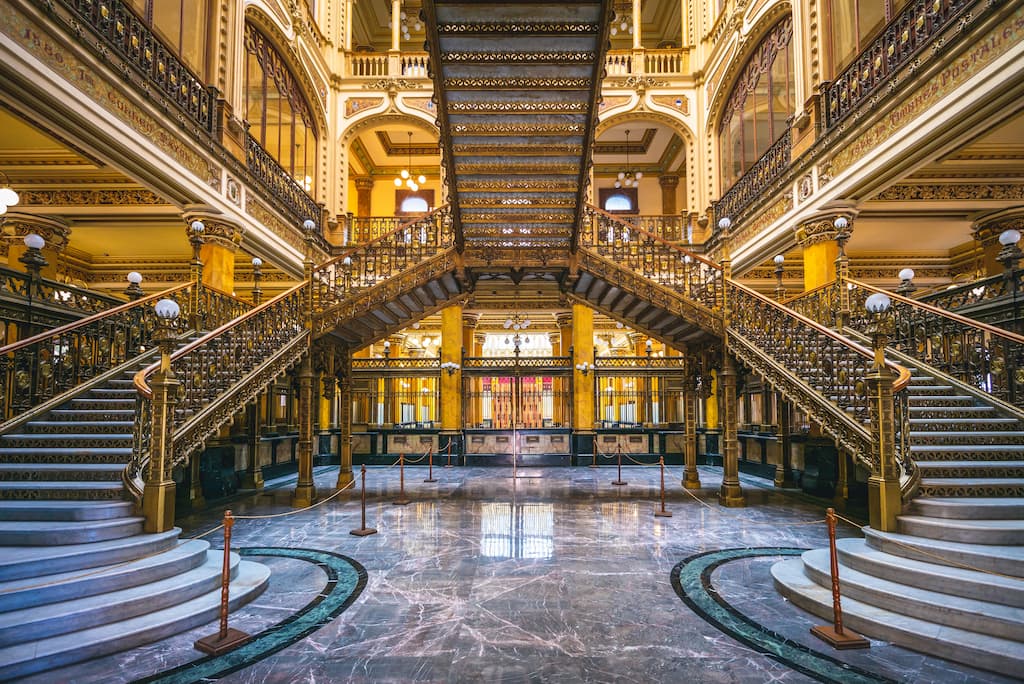
Speaking of surplus palaces, the Palacio de Correos was originally built to house the department in charge of post! As strange as that might seem in the age of email, it was apparently an important enough function that the resulting headquarters are stunning, particularly the interiors, which are a dazzling mixture of metal, marble, and frescoed plaster.
We wouldn’t say it’s worth going out of your way to visit the Palacio Postal (as it’s also known), but since it’s right across the road from the Palacio de Belles Artes, you’d be silly not to tack it on as an intriguing extra.
#26 Universidad Nacional Autónoma de México (UNAM)
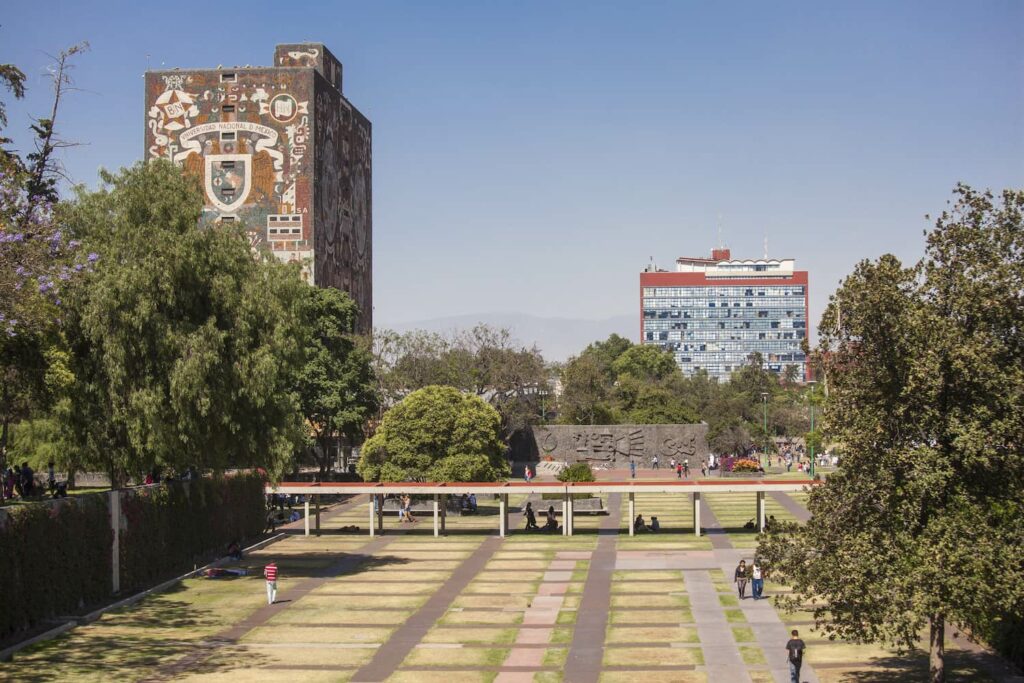
Why would a college be worth visiting, you ask? Well, because the main campus of the National Autonomous University of Mexico was designed and decorated by some of the most ground-breaking Mexican minds of the 20th century. In fact, UNESCO recognised the central Ciudad Universitaria (University City) complex as a World Heritage Site in 2007.
It’s easy to see why, as there are lots of murals and sculptures built into the fabric of the university. Our favourite building is, perhaps rather unoriginally, the Central Library, whose walls are covered by a striking artwork entitled The Historical Representation of Culture.
#27 Monumento a la Madre

Inaugurated in 1949, destroyed by an earthquake in 2017, and reopened in 2018, the Mother’s Monument is a rather brutalist creation that has to battle not just seismic activity but also graffiti artists.
Rather like the Palacio de Correos, this isn’t one of the landmarks of Mexico City that you need to go out of your way to come see, but it is halfway between the Monumento a la Revolucion and El Angel, so easy to check out en route.
#28 Paseo de la Reforma
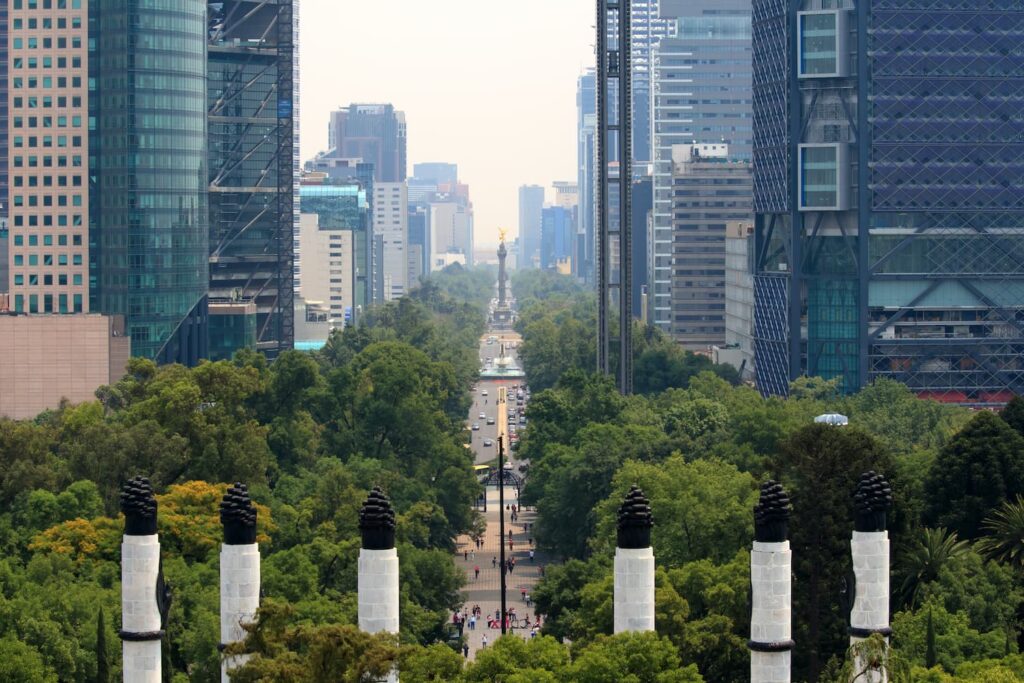
The Paseo de la Reforma isn’t a landmark per se, but the avenue is an interestingly ambitious man-made project, one that began in the Spanish Empire and continued through the subsequent republican governments.
You can have a very interesting day walking along the central part of Reforma, starting from Chapultepec Forest and heading east towards the Centro Historico. On the way, you’ll pass some of the city’s tallest skyscrapers (including Torre Mayor, Chapultepec Uno, and Torre Reforma), most iconic memorials (El Angel and Monumento a la Revolucion), and all manner of restaurants and malls.
#29 Biblioteca Vasconcelos
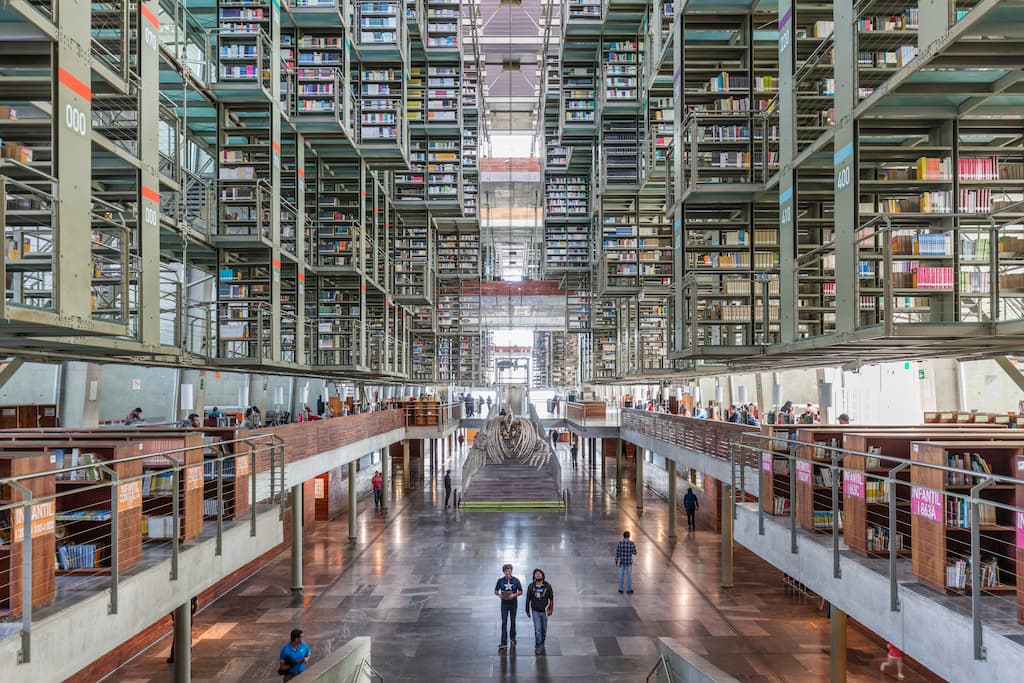
Just outside the Buenavista metro station, the Biblioteca Vasconcelos is one for architecture aficionados. While we’re tempted to call it a hideous monstrosity and leave it at that, it’s also breathtaking to walk into the cavernous insides and see all the floating floors lined with shelves.
The building has variously been described as an ark for human knowledge, a cemetery filled with books, and a futuristic prison, but to us, it most resembled the carcass of some great artificial beast, its metal bones splayed open – though it could just have been the library’s whale skeleton sculpture that created that morbid impression!
Famous Mexico City Landmarks: FAQs
What is Mexico City known for?
There are loads of noteworthy landmarks in Mexico City, including the elaborately constructed Metropolitan Cathedral, the millennia-old Mesoamerican Teotihuacan, and the Frida Kahlo Museum. The capital is also known for its food, from world-famous fine-dining eateries to simple street stalls selling tacos and quesadillas, so make sure you don’t forget to make time just to eat!
What is the famous statue in Mexico City?
The Angel de la Independencia is easily the most famous and most recognisable statue in Mexico City, but there’s also been quite a bit of buzz in recent years about the statue replica of the indigenous sculpture Young Woman of Amajac. This now occupies the ‘glorieta’ (roundabout) along Reforma where Christopher Columbus’ likeness was removed following controversy over his brutal methods of colonisation.
Does Mexico City have national landmarks?
Yes, CDMX has loads of national landmarks. Some of the most famous monuments in Mexico City include the art nouveau Palacio de Bellas Artes, the colonial-era Chapultepec Castle, and the Palacio Nacional, which hosts the Mexican government as well as a famous mural on the history of the nation by Diego Rivera.
What is the most visited place in Mexico City?
It’s impossible to say definitively what the most visited place in Mexico City is because many religious buildings, like the Metropolitan Cathedral and the Basilica of Guadalupe, are not ticketed. However, the National Museum of Anthropology, with its fascinating documentation of Mesoamerican civilization, is often cited as having the most confirmed visitors.
Why is Mexico City a tourist attraction?
One of the main attractions of Mexico City is its rich history, which dates back centuries. The fabric of the modern-day metropolis is made up of indigenous, colonial, imperial, and republican pasts, creating a multifaceted culture that is expressed through artwork, handicrafts, architecture, and cuisine.
Landmarks In Mexico City: The Wrap-Up
Even though we’ve been living part-time in CDMX for a few years now, we’re sure we’ve not seen all the landmarks in Mexico City worth seeing. However, this list should have more than enough inspo for both first-time and repeat visitors, showcasing a mix of natural and man-made attractions that set the city apart from anywhere else in the world.
MORE CDMX TRAVEL TIPS

